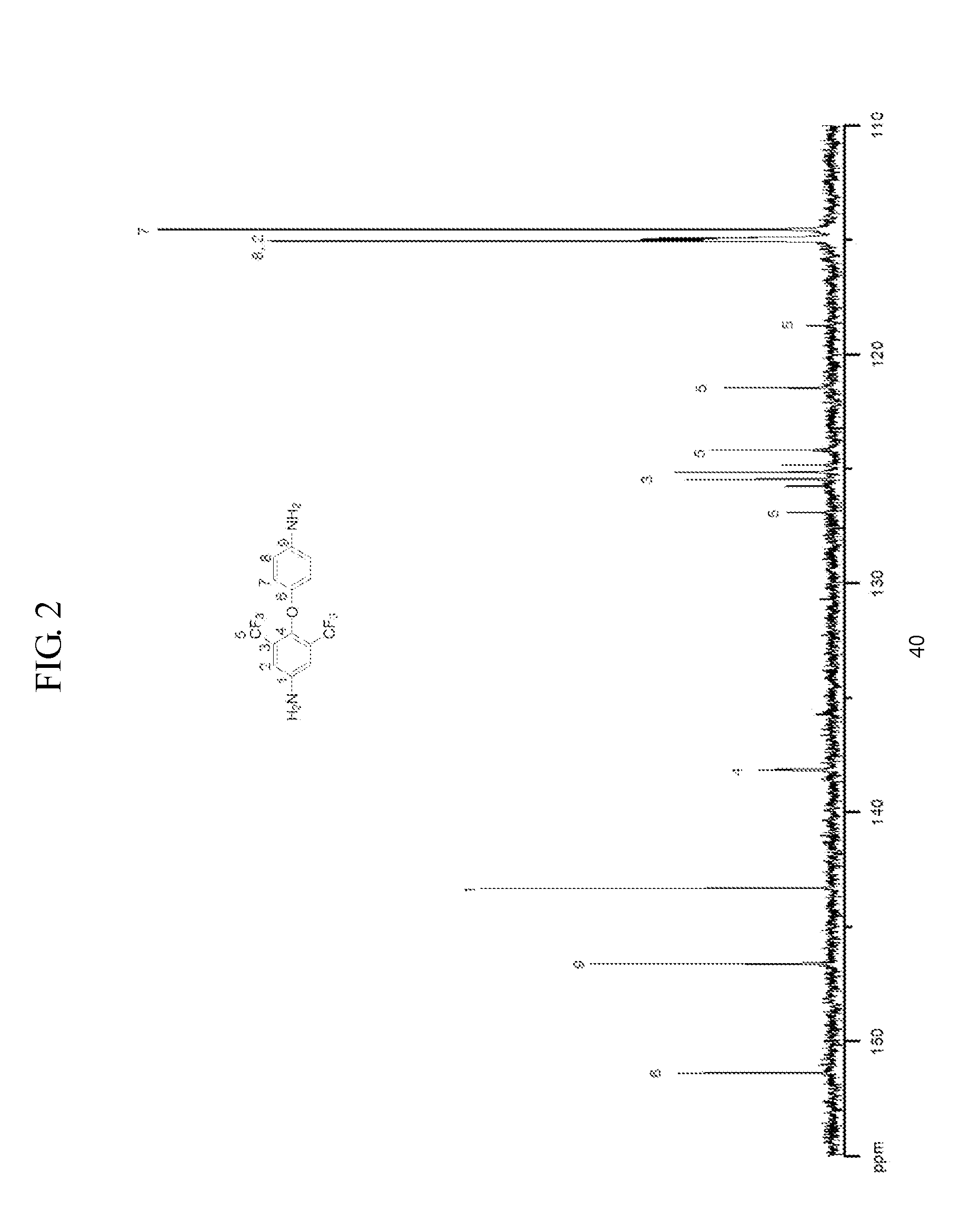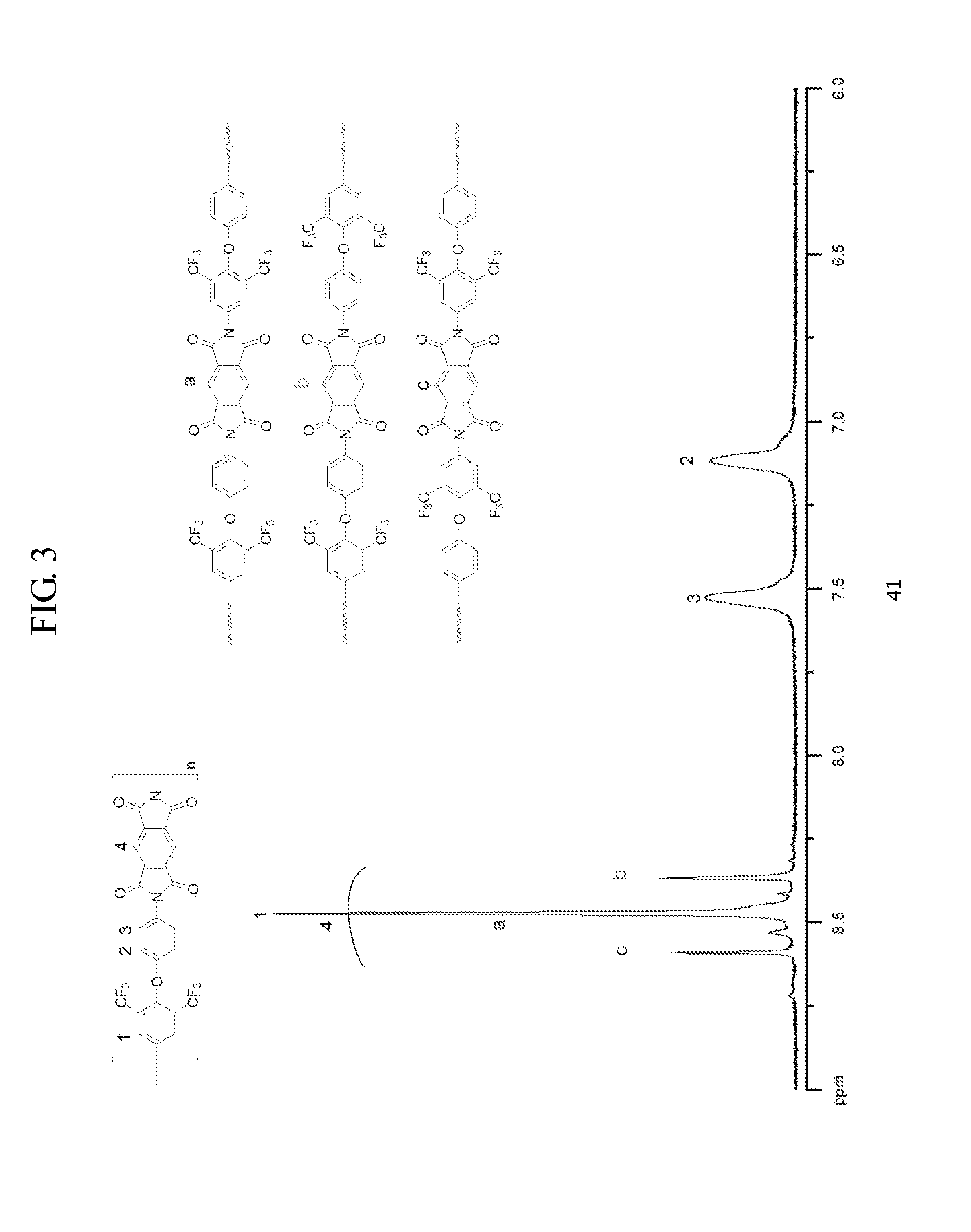Asymmetric Diamine Compounds Containing Two Functional Groups and Polymers Therefrom
a technology of diamine compounds and functional groups, applied in the field of new diamine compounds, can solve the problems of low processibility, difficult polymer films or fibers therefrom, low solubility, etc., and achieve the effects of high solubility, superior properties of polyimide, and robustness with rigid structur
- Summary
- Abstract
- Description
- Claims
- Application Information
AI Technical Summary
Benefits of technology
Problems solved by technology
Method used
Image
Examples
example 1
Preparation of Soluble Polyimide
[0115]Diamine compounds 0.39801 g (1.184 mmol) prepared (supra) were completely dissolved in 4.9 mL of purified NMP and an equivalent amount of 1,2,4,5-benzene tetracarboxylic dianhydride (PMDA) 0.25850 g (1.185 mmol) as a solid was added to the solution at room temperature and the solution was stirred for 4 hours to give polyamic acid.
[0116]To the solution was added 4.9 mL of NMP solvent, and the temperature was raised to 190° C., and a small amount of chlorobenzene was added to remove water produced during imidization and the solution was stirred for 6 hours. In this case, precipitation or gel formation during the reaction was not observed. After cooling to room temperature by diluting with 2 ml of NMP, the viscous solution was treated with a mixture of methanol and water to promote precipitation, which was washed several times with excess amounts of water and hot methanol, followed by drying in vacuum at 70° C. to obtain polymer.
[0117]1H NMR (DMSO-...
example 2
[0127]The Example 1 was used to give soluble polyimide, except that 3,3′,4,4′-biphenyl tetracarboxylic dianhydride (BPDA) 0.34793 g (1.183 mmol) was used instead of PMDA, and diamine compound 0.39739 g (1.182 mmol) synthesized from the synthetic example. There was no precipitation or gel formation during reaction.
[0128]1H NMR (DMSO-d6, 400 MHz, ppm): 8.435 (s, 2H), 8.388 (m, 4H), 8.163 (t, J=7.7 Hz, 1H), 8.086 (t, J=7.6 Hz, 1H), 7.513 (d, J=8.4 Hz, 2H), 7.041 (d, J=8.1 Hz, 2H).
[0129]Some of the synthesized polymer was made as a 7.5% solution of DMAc by weight which was then coated onto glass plate, followed by placing the glass plate at 100° C. temperature under vacuum for 24 hours to remove the solvent to obtain a transparent and rigid film.
[0130]FTIR (film, cm−1): 1779, 1727 (C═O stretching of imide); 1620, 1509, 1475 (Aromatic C═C); 1383 (C—N stretching of imide); 1298, 1253 (—O—); 1202, 1168, 1146, 1120 (C—F in CF3); 738 (Imide ring deformation).
example 3
[0131]The Example 1 was used to give soluble polyimide, except that 3,3′,4,4′-benzophenone tetracarboxylic dianhydride(BTDA) 0.3808 g (1.182 mmol) was used instead of PMDA, and diamine compound 0.3964 g (1.179 mmol) synthesized from the synthetic example. There was no precipitation or gel formation during reaction.
[0132]1H NMR (DMSO-d6, 400 MHz, ppm): 8.433 (s, 2H), 8.244 (m, 6H), 7.477 (d, J=7.8 Hz, 2H), 7.074 (d, J=8.1 Hz, 2H).
[0133]Some of the synthesized polymer was made as a 7.5% solution of DMAc by weight which was then coated onto glass plate, followed by placing the glass plate at 100° C. under vacuum for 24 hours to remove the solvent to obtain a transparent and rigid film.
[0134]FTIR (film, cm−1): 1782, 1731 (C═O stretching of imide); 1678 (diaryl ketone of BTDA); 1619-1475 (Aromatic C═C); 1385 (C—N stretching of imide); 1298, 1248 (—O—); 1206, 1164, 1146 (C—F in CF3); 720 (Imide ring deformation).
PUM
| Property | Measurement | Unit |
|---|---|---|
| temperature | aaaaa | aaaaa |
| temperature | aaaaa | aaaaa |
| thickness | aaaaa | aaaaa |
Abstract
Description
Claims
Application Information
 Login to View More
Login to View More - R&D
- Intellectual Property
- Life Sciences
- Materials
- Tech Scout
- Unparalleled Data Quality
- Higher Quality Content
- 60% Fewer Hallucinations
Browse by: Latest US Patents, China's latest patents, Technical Efficacy Thesaurus, Application Domain, Technology Topic, Popular Technical Reports.
© 2025 PatSnap. All rights reserved.Legal|Privacy policy|Modern Slavery Act Transparency Statement|Sitemap|About US| Contact US: help@patsnap.com



